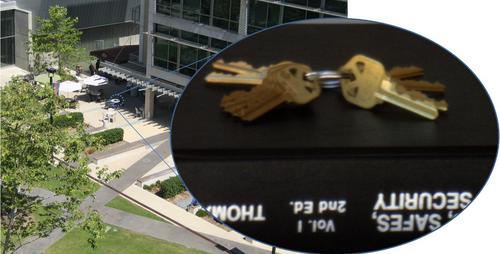News Release
Keys Can be Copied From Afar, Jacobs School Computer Scientists Show
San Diego, CA, October 30, 2008--UC San Diego computer scientists have built a software program that can perform key duplication without having the key. Instead, the computer scientists only need a photograph of the key.
“We built our key duplication software system to show people that their keys are not inherently secret,” said Stefan Savage, the computer science professor from UC San Diego’s Jacobs School of Engineering who led the student-run project. “Perhaps this was once a reasonable assumption, but advances in digital imaging and optics have made it easy to duplicate someone’s keys from a distance without them even noticing.”
Professor Savage presents this work on October 30 at ACM’s Conference on Communications and Computer Security (CCS) 2008, one of the premier academic computer security conferences.
 |
| Scenes from one of the proof-of-concept telephoto experiments. The computer scientists successfully decoded this key image, captured at a distance of 195 feet. |
The bumps and valleys on your house or office keys represent a numeric code that completely describes how to open your particular lock. If a key doesn’t encode this precise “bitting code,” then it won’t open your door.
In one demonstration of the new software system, the computer scientists took pictures of common residential house keys with a cell phone camera, fed the image into their software which then produced the information needed to create identical copies. In another example, they used a five inch telephoto lens to capture images from the roof of a campus building and duplicate keys sitting on a café table about 200 feet away.
“This idea should come as little surprise to locksmiths or lock vendors,” said Savage. “There are experts who have been able to copy keys by hand from high-resolution photographs for some time. However, we argue that the threat has turned a corner—cheap image sensors have made digital cameras pervasive and basic computer vision techniques can automatically extract a key’s information without requiring any expertise.”
 |
| Stefan Savage, a computer science professor from UC San Diego’s Jacobs School of Engineering led the student-run "Sneakey" project. |
“If you go onto a photo-sharing site such as Flickr, you will find many photos of people’s keys that can be used to easily make duplicates. While people generally blur out the numbers on their credit cards and driver's licenses before putting those photos on-line, they don’t realize that they should take the same precautions with their keys,” said Savage.
As for what to do about the key duplication threat, Savage says that companies are actively developing and marketing new locking systems that encode electromagnetic secrets as well as a physical code. “Many car keys, for example, have RFID immobilizer chips that prevent duplicated keys from turning the car on,” he says. In the meantime, he suggests that you treat your keys like you treat your credit card and “keep it in your pocket unless you need to use it.”
How it works
The keys used in the most common residential locks in the United States have a series of 5 or 6 cuts, spaced out at regular intervals. The computer scientists created a program in MatLab that can process photos of keys from nearly any angle and measure the depth of each cut. String together the depth of each cut and you have a key’s bitting code, which together with basic information on the brand and type of key you have, is what you need to make a duplicate key.
 |
| Benjamin Laxton, the first author on the paper who recently earned his Master’s degree in computer science from UC San Diego. |
“The program is simple. You only need to click a few control points in the image of the key and the ‘Sneakey’ program does the rest. It normalizes the key’s size and position so that each pixel then corresponds to a known distance. From this information, the height of each of the key cuts can easily be computed and likewise the bitting code can be extracted,” explained Benjamin Laxton, the first author on the paper who wrote the Sneakey program and recently earned his Master’s degree in computer science from UC San Diego.
The researchers have not released their code to the public, but they acknowledge that it would not be terribly difficult for someone with basic knowledge of MatLab and computer vision techniques to build a similar system.
 |
| Kai Wang, a UC San Diego computer science graduate student and an author on the key duplication paper, points to the roof where researchers photographed and decoded keys sitting on a table at the cafe where he now sits. |
“Technology trends in computer vision are at a point where we need to consider new risks for physical security systems,” said Kai Wang, a UC San Diego computer science graduate student and author on the new paper. Wang is a computer vision researcher working on the creating systems capable of reading text on product packaging. This is part of a larger project on creating a computerized personal shopping assistant for the visually impaired from the lab of computer science professor Serge Belongie.
As a computer security expert, Savage said he particularly enjoyed working on a project with computer vision students.
“UC San Diego is very supportive of interdisciplinary work. There are many opportunities for students and faculty to get their hands dirty in fields they may not know much about a lot at first,” said Savage.
Paper citation:
“Reconsidering Physical Key Secrecy: Teleduplication via Optical Decoding ,” by Benjamin Laxton, Kai Wang, and Stefan Savage from the Department of Computer Science and Engineering at UC San Diego’s Jacobs School of Engineering.
ACM CCS 2008, Alexandria, VA, October 2008.
Project Website: http://vision.ucsd.edu/~blaxton/sneakey.html
Media Contacts
Daniel Kane
Jacobs School of Engineering
858-534-3262
dbkane@ucsd.edu